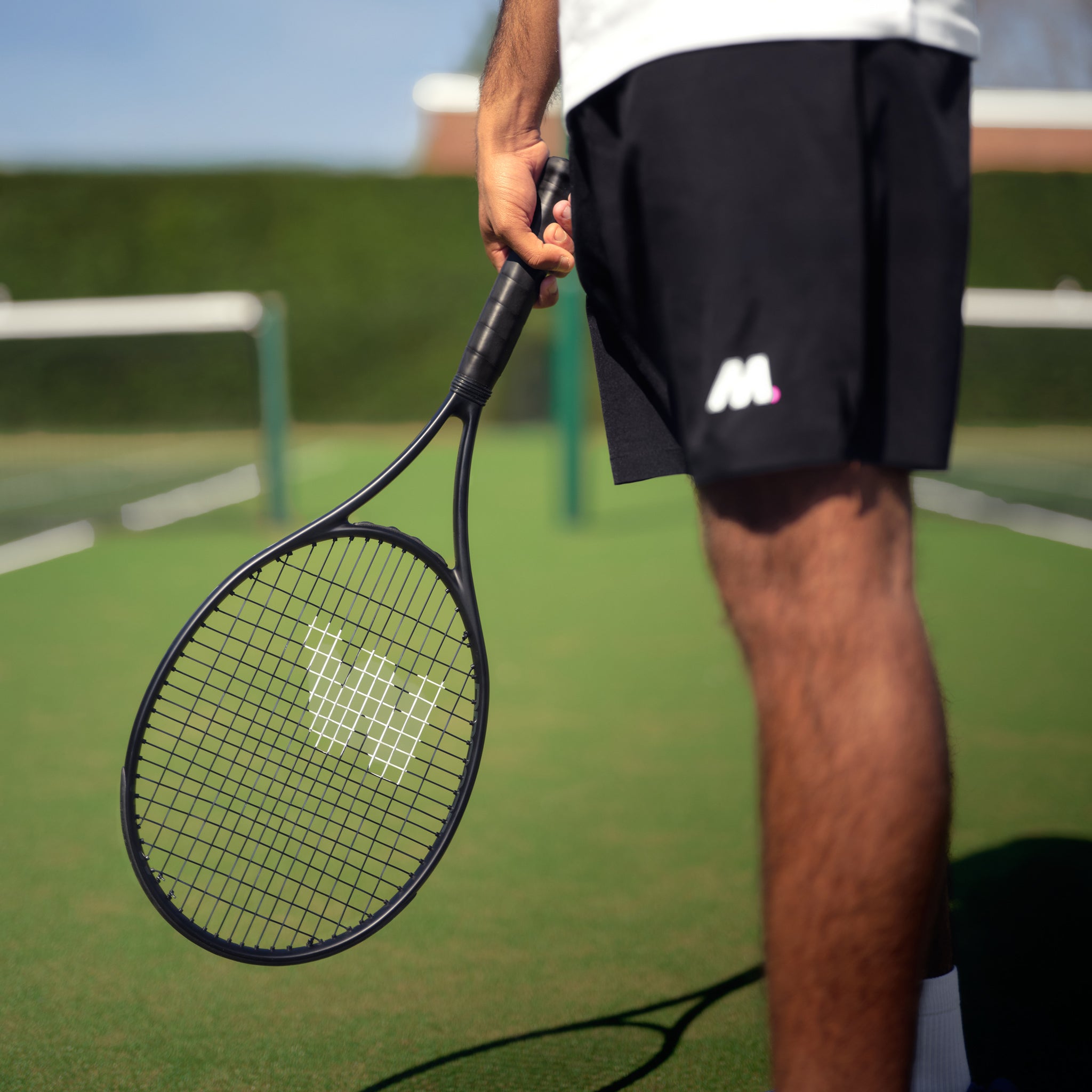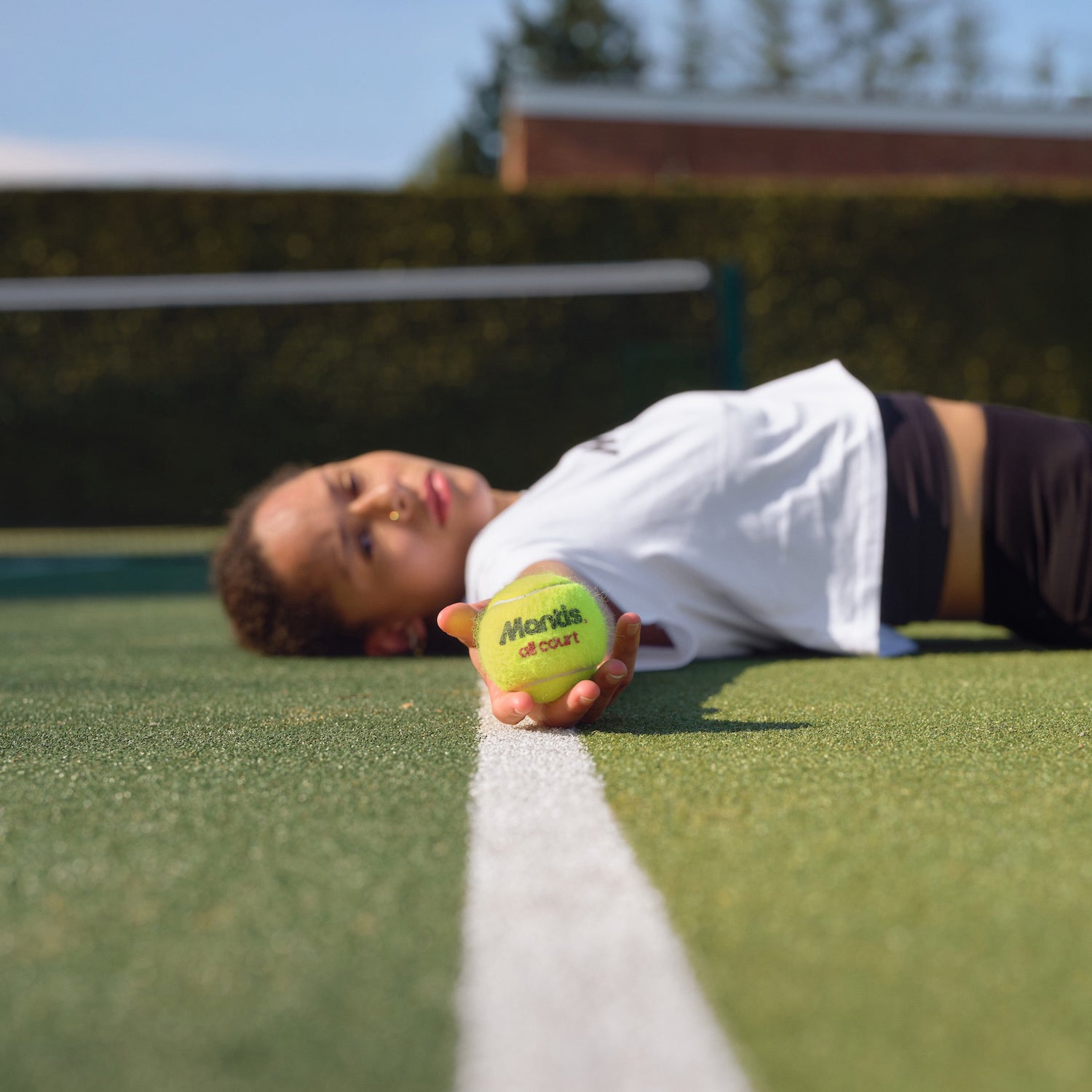
Finding the best tennis strings for spin is a game-changer for so many players. It usually leads you straight to shaped polyester strings, and for good reason. For more on building the perfect setup, check out our comprehensive tennis string guide. They’re brilliant at grabbing the ball, and that quick snap-back they have is what sends it flying with a ton of revolutions per minute (RPM).
If you’re chasing that competitive edge, getting to grips with this technology is the first step to hitting a heavier, more punishing shot. Here at Mantis, we're obsessed with performance-driven gear because we know it’s the little details that transform your game.
Why the Right Strings Are Your Secret Weapon for Spin
In today’s game, spin isn’t just a nice-to-have—it’s everything. It's the core of a winning strategy. A ball loaded with heavy topspin dives back down into the court like a hawk, letting you swing bigger and harder without sailing it long. On top of that, it produces a high, awkward bounce that shoves your opponent right off the baseline.
While your technique is obviously paramount, the strings are where the magic happens. They’re the only thing that touches the ball, making them the ultimate tool for dictating its rotation.
Think of your stringbed as the engine that drives your spin. Everything from the material and shape to the tension works in concert to either supercharge your RPMs or hold them back. This pursuit of the perfect spin-friendly setup has spurred on some incredible advancements in string technology.
The Rise of Spin-Focused Strings
The type of string you use is arguably the biggest single factor in your spin potential. Here in the UK, players have overwhelmingly moved towards polyester (or 'poly') strings for their incredible spin and control. In fact, recent reports show that polyester strings make up about 62% of all tennis string sales in the UK market.
This isn't just a pro-level trend anymore; it reflects a massive shift among club and intermediate players who want more control over their game. It proves that more and more players are realising their strings are a performance variable they can tweak for a real on-court advantage.
What Makes a String Spin-Friendly?
So, what actually gives a string its spin-friendly credentials? It really comes down to a few key ingredients, which we’ll break down throughout this guide.
- Material Composition: Stiffer materials, like polyester, are the kings here. They deform on impact and then violently snap back into place, which is the primary mechanism for generating spin.
- String Shape: This is a big one. Textured or shaped strings—think hexagonal, octagonal, or twisted—have sharp edges that literally bite into the felt of the ball. This extra friction creates a massive boost in rotation.
- Low-Friction Surface: A slick coating is the secret sauce. It lets the main strings slide freely over the cross strings during impact and then snap back with even more force. This catapults the ball off the stringbed with a final, vicious kick of spin.
Once you understand these principles, you can look past the marketing hype and start making choices that genuinely suit your game. This guide will give you the knowledge you need to pick the best tennis strings for spin and truly unlock your potential.
How Your Strings Actually Create Spin
To really get a feel for the best tennis strings for spin, it helps to understand the physics happening in that split-second the ball hits your racquet. Generating that heavy, kicking topspin isn't just one action; it's a dynamic, two-part process. For more on the basics, you can always check out our detailed guide on selecting the ideal tennis racket. Here at Mantis, we're firm believers that knowing the 'how' behind your gear makes you a much smarter player on the court.
So, what are these two parts? They're known as string 'bite' and string 'snap-back'. They work in tandem, but they're distinct forces, and different strings are designed to be better at one or both.
The First Ingredient: String Bite
Think of your strings like the tread on a car tyre. When you hit the accelerator, that tread needs to grip the road. String bite is exactly the same idea. It’s all about how well the strings can physically grab onto the fuzzy felt of the tennis ball when they make contact.
A perfectly round, smooth string can only create so much friction. This is where shaped or textured strings really shine. Their profiles—often hexagonal, octagonal, or even twisted—create sharp edges that act like tiny claws. These edges dig into the ball's surface, creating a far stronger frictional grip than a smooth string ever could.
This initial grip is the first crucial step in getting the ball to rotate. The better the string can bite into the ball, the more direct influence you have over its spin. It's like getting a secure hold on something before you give it a powerful twist.
"The difference between a round and a shaped string is immediately noticeable. The shaped profile provides a tangible sense of grip on the ball, allowing players to brush up more aggressively and confidently on their shots."
The Second Ingredient: The Snap-Back Effect
While bite gets things started, the real engine of modern spin is the snap-back effect. This phenomenon is what separates decent spin from the kind of heavy, dipping shots that dominate today's game. It’s a rapid, almost violent, sequence of movements happening right there in your stringbed.
Here’s a quick breakdown of what happens during impact:
- Impact and Movement: The ball strikes the stringbed. The main strings (the vertical ones) are not only pushed back but also slide sideways across the cross strings.
- Storing Energy: This movement stretches the main strings like a loaded slingshot, storing a huge amount of potential energy. They are now way out of their normal alignment.
- Violent Recoil: As the ball starts to leave the racquet, the displaced main strings violently snap back into their original position. This lightning-fast recoil acts like a catapult, adding a final, powerful burst of rotation to the ball just as it launches off the strings.
This entire process happens in milliseconds. The speed and power of this snap-back directly translate into the RPMs (revolutions per minute) on the ball. A more efficient snap-back means a much higher spin rate.
Why Polyester Strings Are the Kings of Snap-Back
This snap-back effect is precisely why polyester strings have become the go-to choice for almost every serious spin player. Their material properties are practically custom-made to maximise this effect.
- Low-Friction Surface: Polyester is naturally slick. Many modern co-poly strings take this even further with advanced low-friction coatings. This lets the main strings slide over the cross strings with almost no resistance, allowing for more sideways movement and a much more explosive snap-back.
- Stiffness and Resilience: The inherent stiffness of polyester means it deforms and recoils with incredible speed and force. Softer strings tend to absorb and dampen energy, but polyester returns it right back into the ball in the form of rotational energy.
Put simply, polyester strings create the perfect storm for spin. They have a firm structure and a slick surface, which allows for maximum string movement and a powerful, energetic return to position. Understanding this interplay between bite and snap-back is the real key to choosing a string that will genuinely amplify your ability to shape your shots and control the court.
Choosing the Right String Material for Spin
Picking the right string material is probably the single biggest decision you'll make when it comes to generating more spin. To get a handle on the basics first, our comprehensive tennis string guide is a great place to start. The material itself dictates how stiff the string is, what it feels like at impact, and, most importantly, how it grabs and snaps back on the ball.
While there's a whole world of strings out there, one type has become the undisputed king for modern, heavy-topspin tennis.
Here at Mantis, we're big believers in understanding the 'why' behind your gear. It helps you make smarter choices on court. So, let's dive into the main string materials and see how they stack up for spin.
Polyester: The King of Spin
If you're an intermediate or advanced player looking for the best tennis strings for spin, polyester (or 'poly') is where you should be looking. Its dominance comes down to a unique blend of properties that are tailor-made for ripping the ball with heavy rotation.
Polys are famous for their firm feel and low-friction surface. This stiffness is key—it allows the strings to deform as the ball hits and then violently snap back into place, creating that all-important snap-back effect. At the same time, the slick surface lets the main strings slide easily over the cross strings, which supercharges this movement and launches the ball with incredible rotation.
Within the poly family, you'll generally find two flavours:
- Smooth Polys: These have a classic, round profile. They get most of their spin from that pure snap-back mechanism and give you a really consistent, predictable feel off the stringbed.
- Textured Polys: These are engineered with a shaped profile – think hexagonal, octagonal, or even twisted. This design adds an extra layer of mechanical 'bite', where the sharp edges physically grab the felt of the ball, piling on even more spin on top of the snap-back.
The shift towards spin-friendly strings isn't just a trend; the numbers back it up. In the highly competitive UK tennis scene, around 35% of tournament-level players in the UK's Premier Tennis Leagues now use spin-enhancing polyester strings. That's a 10% jump from previous years, showing just how much players are prioritising rotation in their game.
Other Materials and Their Spin Limitations
Polyester may rule the roost for spin, but it's worth understanding why other materials just can't compete in this area. Each has its own strengths, but they're missing the secret sauce for generating massive RPMs.
Natural Gut Made from cow intestines, natural gut is the absolute gold standard for feel, comfort, and raw power. Its weakness for spin, however, lies in its naturally textured, high-friction surface. This causes the strings to grip each other, preventing the smooth sliding motion needed for a powerful snap-back.
Natural gut offers unparalleled touch and playability, but its inherent friction means it can't match the RPMs of a modern polyester string. It excels in feel, not spin.
Multifilament Designed to mimic the playability of natural gut, these strings are made from thousands of tiny fibres bonded together. They are incredibly comfortable and easy on the arm, but just like gut, they are too soft and create too much friction to generate major snap-back. They tend to absorb the ball's impact rather than firing it back with added rotation.
Synthetic Gut This is your typical solid-core nylon string, often with a few outer wraps. It’s a great all-rounder, offering a decent mix of playability and durability at a wallet-friendly price. However, it has neither the stiffness nor the slick surface of a poly, which puts it at the bottom of the pile for spin potential.
String Material Comparison for Spin Generation
To make things clearer, this table breaks down how the main string materials perform when it comes to generating spin, along with their other key characteristics.
| String Material | Spin Potential | Feel & Comfort | Durability | Best Suited For |
|---|---|---|---|---|
| Polyester | Excellent | Firm to Stiff | Excellent | Intermediate to advanced players seeking maximum spin and control. |
| Natural Gut | Fair | Excellent | Good | Players prioritising feel, power, and comfort above all else. |
| Multifilament | Poor to Fair | Very Good | Fair to Good | Players needing arm comfort and a gut-like feel. |
| Synthetic Gut | Poor | Good | Good | Beginners, recreational players, and those on a budget. |
As you can see, if spin is your top priority, polyester is in a league of its own. But what if you find a full bed of poly too demanding on your arm?
Hybrid Stringing: A Blend of Spin and Comfort
For players who find a full set of polyester a bit too harsh but still want that spin, a hybrid setup is a brilliant solution. This simply means using two different types of string in your racquet—one for the mains and one for the crosses.
One of the most popular and effective combos is:
- Mains: A spin-friendly polyester string.
- Crosses: A softer string, like natural gut or a multifilament.
This setup lets you have your cake and eat it too. The poly mains are the dominant influence, providing the bite and snap-back you need for heavy spin. Meanwhile, the softer crosses cushion the impact, improve the overall feel, and add a little extra pop, making the stringbed far more arm-friendly. Hybrid stringing is a fantastic way to fine-tune your racquet's performance to get the exact blend of spin and comfort you need.
How Gauge and Tension Impact Your Spin
Once you’ve picked a string material, the real fine-tuning begins. For a much deeper dive, our guide on tennis racquet stringing tension is the perfect next step. This is where we get into gauge and tension – two variables that dramatically change how your racquet feels, performs, and, crucially, how much spin you can wring out of the ball. Getting this right is what turns a decent string setup into a truly brilliant one.
Think of gauge and tension as the final calibration for your spin machine. They let you customise the string's behaviour to perfectly match your swing and what you want the ball to do.
Let's break down how each piece of the puzzle works.
String Gauge: The Thickness Factor
String gauge is just a fancy term for how thick the string is. In tennis, we measure this with a number followed by a 'G' or in millimetres (mm). It’s a bit backwards, which can be confusing at first: the higher the gauge number, the thinner the string.
- Thicker Strings (e.g., 16G / 1.30mm): These are the workhorses. They last longer simply because there's more material to wear through. The downside? Their thickness means they can't "bite" into the ball's fuzz quite as sharply.
- Thinner Strings (e.g., 17G / 1.25mm or 18G / 1.20mm): Now we're talking spin. A thinner string can really dig into the ball's surface on impact. This sharper bite lets the string grip the ball more aggressively, creating a noticeable jump in your spin potential.
The trade-off, of course, is durability. A thinner 17G or 18G string will pop faster, especially for players who hit with a lot of topspin. But for those chasing every last RPM, the extra spin is often well worth the shorter lifespan.
The Tension Secret: Why Lower Is Often Better for Spin
This is probably one of the most misunderstood parts of stringing for spin. Logic seems to suggest that tighter strings would grip the ball better and create more rotation. Funnily enough, the opposite is usually true.
Dropping your string tension will almost always increase your spin potential. It sounds counter-intuitive, but the physics doesn't lie. When you string your racquet at a lower tension (say, below 53 lbs or 24 kg), you get a more flexible, forgiving stringbed.
This added flex does two incredible things for spin:
- Increases Dwell Time: A softer stringbed cradles the ball, letting it sink in deeper and stay on the strings for a split-second longer. This extra contact time, what we call 'dwell time', gives you more time to brush up the back of the ball and impart that heavy rotation.
- Amplifies the Snap-Back: The deeper the ball pockets, the further the main strings are forced out of place. This means they have a much longer, more violent journey as they snap back into alignment, catapulting the ball out with significantly more spin.
Think of lower tension as creating a 'slingshot' effect. The strings stretch further on impact, store more energy, and then unleash it all as they snap back, launching the ball with amplified rotation.
Of course, it’s all about finding the right balance. Go too low with the tension and you might start losing control, with balls sailing long. The trick is to experiment and discover that sweet spot where you get maximum spin without sacrificing the precision your game needs.
Finding Your Perfect Setup
There’s no magic number for gauge or tension. The ideal combination is unique to you—your swing, your style, and what you prioritise on court. It’s a process of trial and error.
Here’s a simple way to start dialling in your perfect setup:
- Start in the Middle: String your chosen polyester at a baseline tension around 52 lbs (23.5 kg). It’s a great, neutral starting point.
- Adjust in Small Steps: After a few sessions, decide if you want more spin or more control. On your next restring, drop or raise the tension by just 2 lbs (about 1 kg). It’s a small enough change that it won't throw your game off, but you'll definitely feel the difference.
- Take Notes: Pay close attention. Is the ball dipping into the court better? Are you spraying your flat shots? Keeping a quick log of the tension and how it felt will help you pinpoint your ideal numbers much faster.
By thoughtfully combining the right material, gauge, and tension, you’re no longer just picking a string; you’re engineering a high-performance tool that’s custom-built for your game. This deliberate approach is what separates the good players from the great ones.
Matching Your Strings to Your Playing Style
So, we've unpacked the science behind how strings generate spin—everything from the material to the gauge and tension. If you want a quick refresher on the fundamentals, Mantis has a great tennis string guide that covers the basics before we dive deeper here. Now it's time for the fun part: putting that knowledge to work for your game. The truth is, the "best" tennis string for spin doesn't exist in a vacuum. It's a deeply personal choice, one that has to click with your unique style on the court.
The key is to connect the theory to what you actually do during a match. Think about your strengths, your weaknesses, and how you win points. A string setup that feels like a magic wand for an aggressive baseliner could feel like a wooden plank to an all-court player who thrives on touch and variety. Our goal here is to give you a framework for matching your gear to your game plan.
For the Aggressive Baseliner
Is your game built around planting your feet and ripping powerful groundstrokes from the back of the court? If so, spin isn't just a tool; it's your lifeline. It’s what lets you swing big and hit with punishing depth while still making the ball dive back inside the lines. You need a string that absolutely maximises bite and snap-back to create a heavy, high-kicking ball that bullies your opponents off the court.
For this no-holds-barred style, a shaped co-polyester string is the undisputed champion. Its geometric profile—whether it's hexagonal, octagonal, or even twisted—gives you that raw, aggressive bite on the ball. Combine that with polyester's natural stiffness and low-friction surface, and you get an explosive snap-back effect that sends your spin rate through the roof.
Baseliner's Setup Checklist:
- String Material: Shaped Co-Polyester.
- Gauge: Think about a thinner gauge like 17G (1.25mm) for more bite, but just know you'll be sacrificing some durability.
- Tension: Try experimenting with lower tensions, maybe around 48-52 lbs, to deepen the ball pocket and really crank up that snap-back.
This combination is purpose-built to reward long, fast swings with the kind of heavy, dipping shots that win rallies.
For the All-Court Player
The all-court player is a chameleon, needing a bit of everything. Your game is a blend of baseline power, quick net exchanges, nasty slices, and sneaky drop shots. Spin is obviously still crucial, but you also demand exceptional touch and feel to pull off those delicate shots with any real precision. A full bed of a stiff, shaped poly might just feel too boardy and unresponsive for such a nuanced game.
This is where a hybrid string setup or a softer co-poly really shines. A hybrid—which typically pairs a polyester in the main strings with a softer multifilament or natural gut in the crosses—offers a fantastic compromise. You get the spin and control you need from the poly mains, but it's beautifully blended with the comfort and feel from the softer cross strings.
Alternatively, many modern co-polys are specifically designed to be softer and more forgiving. These can give you great spin potential without the harsh feedback of old-school polyesters, giving you the control for powerful drives and the soft hands needed for a deft volley.
"For players who mix power with finesse, a hybrid setup is a game-changer. It delivers the spin needed from the baseline while providing the sublime touch required for volleys and drop shots, creating a truly all-around performance."
To make things clearer, we've put together a table to help guide your choice based on what you're trying to achieve on court.
Recommended String Setups by Player Profile
| Player Profile | Primary Goal | Recommended String Type | Key Benefit |
|---|---|---|---|
| Aggressive Baseliner | Maximum spin and control on heavy groundstrokes | Full bed of shaped co-polyester | Unmatched bite on the ball and explosive snap-back for heavy, high-RPM shots. |
| All-Court Tactician | A blend of spin, feel, and touch for variety | Hybrid (Poly mains / Multi or Gut crosses) | The "best of both worlds"—spin and control from the poly, comfort and feel from the softer crosses. |
| Counter-Puncher | Control and consistency to redirect pace | Round, softer co-polyester | Predictable response and great control without the harshness of a shaped poly. |
| Junior or Senior Player | Arm comfort with good spin potential | Full bed of multifilament or a very soft co-poly at low tension | Maximises comfort and power, reducing the risk of arm injury while still providing a spin-friendly response. |
Ultimately, this table is a starting point. The real magic happens when you start experimenting to find what feels right for you.
A Framework for Your Decision
Choosing the right string setup really comes down to an honest look at your own game. Before you drop your racquet off for its next restring, ask yourself these crucial questions. Your answers will steer you toward a setup that feels less like a piece of equipment and more like an extension of your body.
- What does my swing look like? If you have a fast, modern "whippy" swing, you can handle the stiffness of a polyester and really make it work for you. But if your swing is more compact or a bit slower, a softer co-poly or a hybrid will give you much-needed power and comfort.
- Where on the court do I win my points? If you live and die by the baseline, make spin and control your top priorities. If you're always looking to move forward and finish at the net, you need to factor in feel and touch for your volleys.
- Is arm comfort a concern? If you've ever dealt with tennis elbow or just have a sensitive arm, please stay away from a full bed of stiff polyester. You'll be much happier with a softer co-poly, a hybrid setup, or by simply dropping your tension significantly.
By thinking through these points, you can go beyond just picking a popular string off the shelf. You can start building a personalised setup that truly unlocks your potential on the court.
Your Top Questions About The Best Tennis Strings for Spin, Answered
Stepping into the world of spin-friendly strings can feel a bit overwhelming. And if you ever need a refresher on the basics, our general tennis string guide is a brilliant starting point. With all the talk of materials, textures, and tensions, it’s natural to have questions. We get it. Here at Mantis, we believe knowledge is power on the court, so we’ve tackled some of the most common queries we hear from players just like you.
Our goal is to cut through the noise and give you clear, practical advice so you can choose the right strings with confidence. You can also approach a coach as they're often a font of knowledge about strings or seek other sources of information such as our favourite tennis industry website RacketBusiness.com.
Will Using Polyester Strings for Spin Hurt My Arm?
This is a big one, and a really important concern. The short answer is: they can be tough on the arm, but it’s completely manageable. The very stiffness that makes polyester strings so good for generating spin also means they send more of a jolt through your arm on impact compared to softer options like natural gut or multifilaments.
That doesn't mean you have to steer clear, though. To get that incredible spin without punishing your arm, we recommend a few simple strategies.
- Drop the tension: Stringing your racquet a bit looser makes a huge difference. It softens the stringbed, making it far more forgiving and comfortable.
- Go for a thinner gauge: A thinner string has more natural flex, so it won’t feel as rigid as a thicker version of the same string.
- Try a hybrid setup: This is a fantastic compromise. By using a polyester string for your mains and a soft multifilament for your crosses, you get a great blend of spin potential and arm-friendly comfort.
At the end of the day, good technique is your best line of defence. Hitting the ball late or with an inefficient motion will put a strain on your arm, no matter what strings you're using.
How Often Should I Restring to Keep My Spin Potential?
That magical 'snap-back' effect you get from fresh polyester strings doesn't last forever. As you play, the strings lose tension and the constant friction of them rubbing together creates little notches in their surface. This kills their elasticity and stops them from sliding and snapping back into place – which is the real engine behind your spin.
Don't wait for a string to break. A 'dead' set of polyester strings is a serious performance killer for any player who relies on spin, even if they look perfectly fine.
A common rule of thumb is to restring as many times per year as you play per week. So, if you're on the court twice a week, you should plan on restringing twice a year.
But for serious competitors, that’s nowhere near enough. A high-performance player will feel a noticeable drop in spin and control after just 10-20 hours of play. If you notice your shots starting to fly long or you just can’t get the ball to dip like it used to, it’s definitely time for a fresh set. Think of regular restringing as an investment in your consistency.
Do Textured Strings Really Create More Spin Than Smooth Ones?
Yes, for the most part, they do give you a slight edge. These strings are built with shaped profiles – think hexagonal, octagonal, or even twisted designs – that create sharper edges. It’s these edges that give you an extra bit of mechanical 'bite' on the felt of the ball.
It’s like adding another weapon to your spin arsenal. While the main source of spin from a poly string is that 'snap-back' action, the aggressive grip from a textured profile just enhances it.
Many players feel this extra grip gives them a more connected feel, boosting their confidence when they’re trying to brush up the back of the ball for heavy topspin or carve out a wicked slice. It's worth remembering, though, that these sharp edges wear down with use. As they become rounded, that spin advantage will start to fade.
Ultimately, choosing between a smooth and a textured poly is all about personal feel. Some players absolutely love the raw, grabby feel of a textured string, while others prefer the buttery, predictable response of a smooth, round poly. The only way to know for sure is to try both and see which one helps you play your best tennis.
At Mantis, we’re dedicated to putting expertly crafted equipment into the hands of players who are serious about their game. Our focus is on performance-driven gear, from racquets to strings, made for people who love tennis. Explore our full range of tennis equipment at https://mantissport.com.








